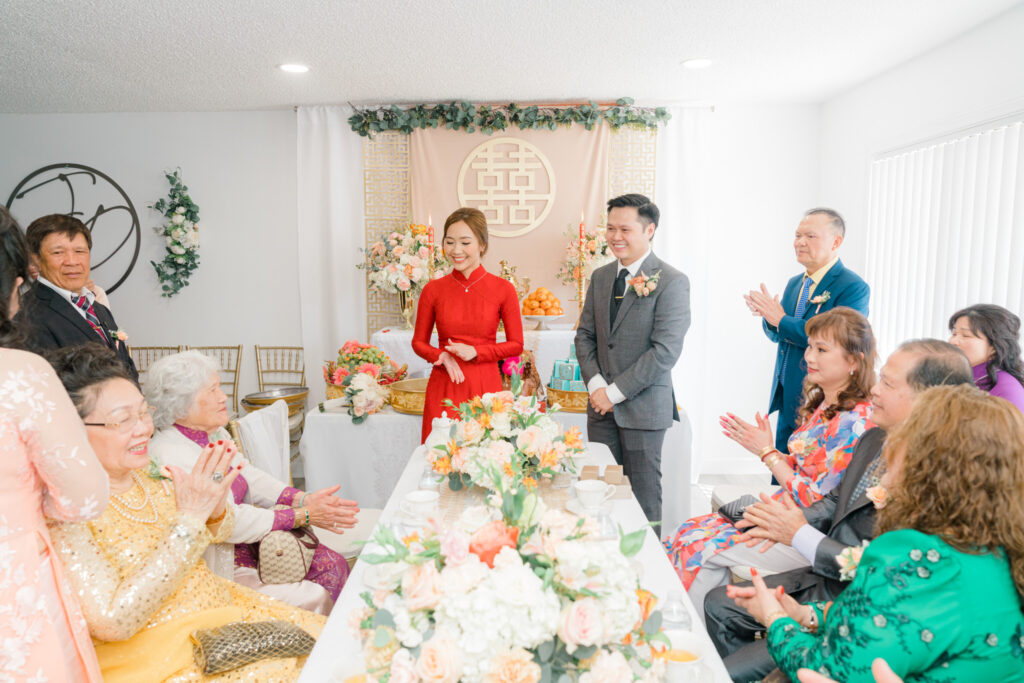
Introduction
Welcome to our comprehensive guide to one of the most revered traditions in Vietnamese culture – the Tea Ceremony. Often seen as the soul of a Vietnamese wedding, this enchanting ritual, known locally as Lễ Gia Tiên, signifies the joining of two families and the continuance of ancestral veneration. It serves as a passage, unifying not just two individuals in love, but two family lineages.
The Tea Ceremony is characterized by its deeply symbolic elements, honoring respect, gratitude, and familial bonds. The groom’s family journeys to the bride’s home, bearing gifts both as a proposal and a gesture of goodwill. The couple, then, serve tea to their parents and elders, acknowledging the roles these loved ones play in their lives and seeking their blessings for the future.
In essence, the Vietnamese Tea Ceremony is more than just a tradition. It is a heartfelt tribute to one’s roots and a joyful celebration of love’s future, wrapped in the elegance of timeless customs. This guide will provide a detailed timeline and step-by-step overview of the ceremony, enabling you to appreciate its significance and helping you execute it with grace and respect. Whether you are a soon-to-be-married couple wishing to incorporate these traditions into your wedding, a guest wanting to understand the customs, or a lover of culture aiming to explore the rich tapestry of Vietnamese traditions, this guide has something for you. Let’s embark on this journey through the ceremonial gates of Vietnamese culture together.
Understanding The Tea Ceremony
The Vietnamese Tea Ceremony, or Lễ Gia Tiên, forms the bedrock of Vietnamese wedding traditions, embodying the philosophy of respect, virtue, and family. Rooted deeply in Confucian and Buddhist ideologies, the ceremony is not merely a ritualistic exchange; it’s an intimate communion between two families.
At the heart of the ceremony lies the practice of serving tea. This humble act is brimming with profound meaning, embodying reverence, humility, and the sanctity of family. As the bride and groom kneel and offer tea to their parents and elders, they symbolically express their gratitude for years of love, care, and guidance. In return, they receive blessings and advice for their future life together.
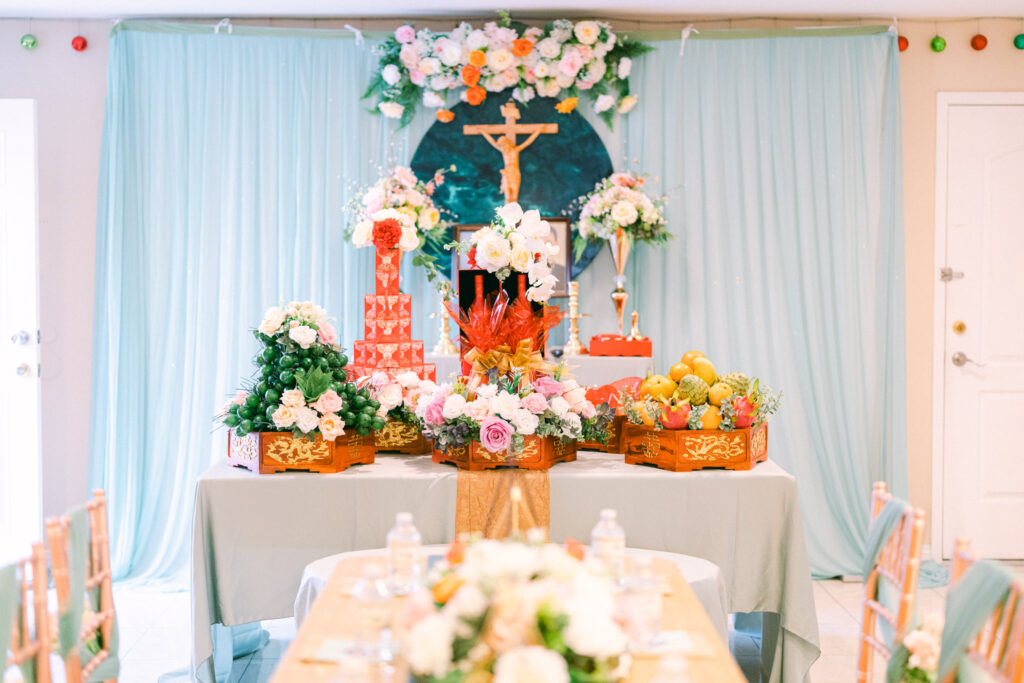
Another key aspect of the Tea Ceremony is the ‘Mâm Quả’, or the Betel and Areca box also called as red tray, symbolizing the ‘flesh and blood’ bond between the couple. The groom’s family presents this box, filled with gifts, as a token of their sincerity and commitment. The bride’s family then examines these gifts, marking their acceptance of the union.
Traditionally, the Tea Ceremony takes place twice, once at the bride’s home and once at the groom’s. In the first ceremony, the groom’s family visits the bride’s family, bringing gifts and requesting the bride’s hand in marriage. After the completion of the formalities and rituals at the bride’s home, the families travel to the groom’s home to perform similar rituals. However, in modern times, many couples choose to conduct only one ceremony, typically at the bride’s home.
Understanding the deeper meaning behind these customs allows us to appreciate the Vietnamese Tea Ceremony for what it truly is—a heartfelt ritual symbolizing love, respect, and the uniting of two families. As we delve further into this guide, we will explore each step of the Tea Ceremony in detail, equipping you with the knowledge to honor this tradition in its fullest authenticity.
Preparation Before The Ceremony
Preparing for the Vietnamese Tea Ceremony involves much more than just the physical arrangement of items. It requires careful attention to detail and a deep respect for tradition. Here’s what typically goes into this preparatory phase.
- Setting up the Altar: The altar setup is a crucial part of the ceremony. The ancestral altar, usually a permanent fixture in Vietnamese homes, is cleaned and adorned with fresh flowers and fruits. Photos of ancestors may also be placed on the altar. Some families may choose to set up a temporary altar if the ceremony is held outside of the home.

- Preparing the Tea Set: The tea set, often gifted by the groom’s family, comprises a teapot and cups. These are cleaned and arranged neatly on a tray. The type of tea used is also significant – lotus tea is a popular choice due to its sweet fragrance and cultural significance.
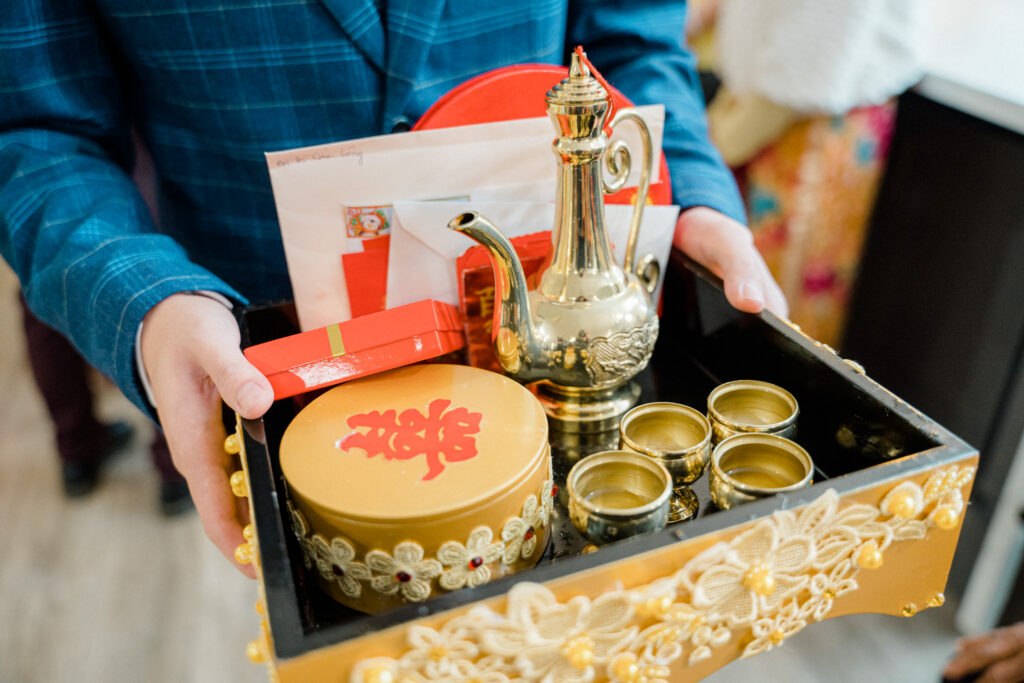
- Arranging the ‘Mâm Qua’: In a traditional Vietnamese wedding, the ‘Mâm Qua’ are the gifts offered by the groom’s family to the bride’s family. The number of gifts can vary, but it is typically an even number, such as six, eight, or ten, which are considered lucky in Vietnamese culture.
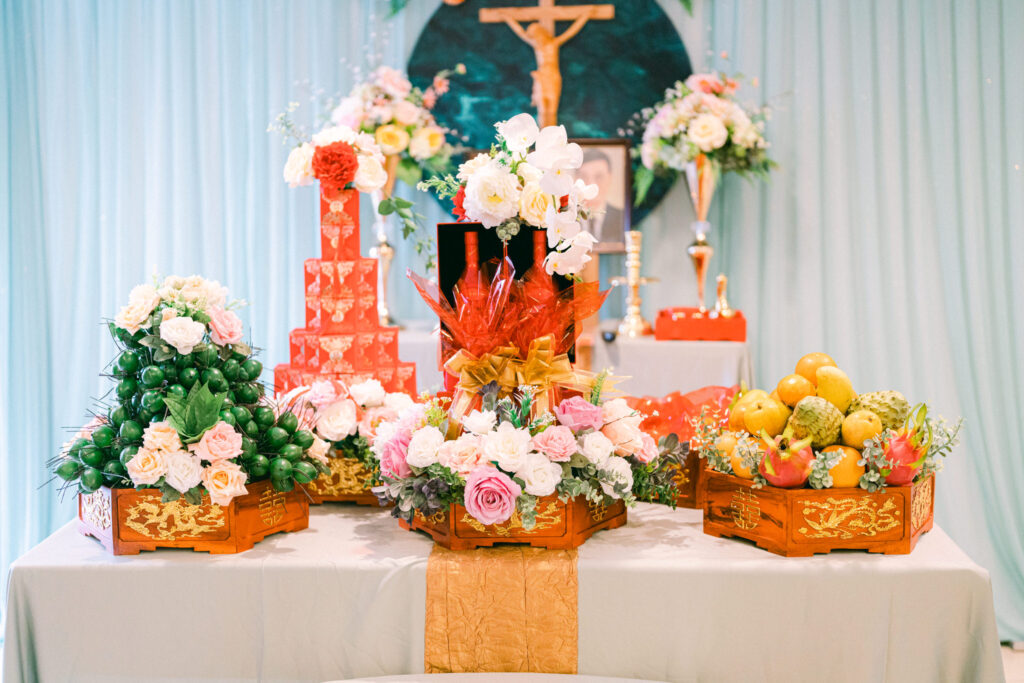
Here’s an example of eight items often included in a ‘Mâm Qua’ and their Vietnamese names:
Betel leaves and areca nuts (Trầu Cau): These symbolize the ideal married couple in Vietnamese culture – they are different, yet only together do they create a perfect match.
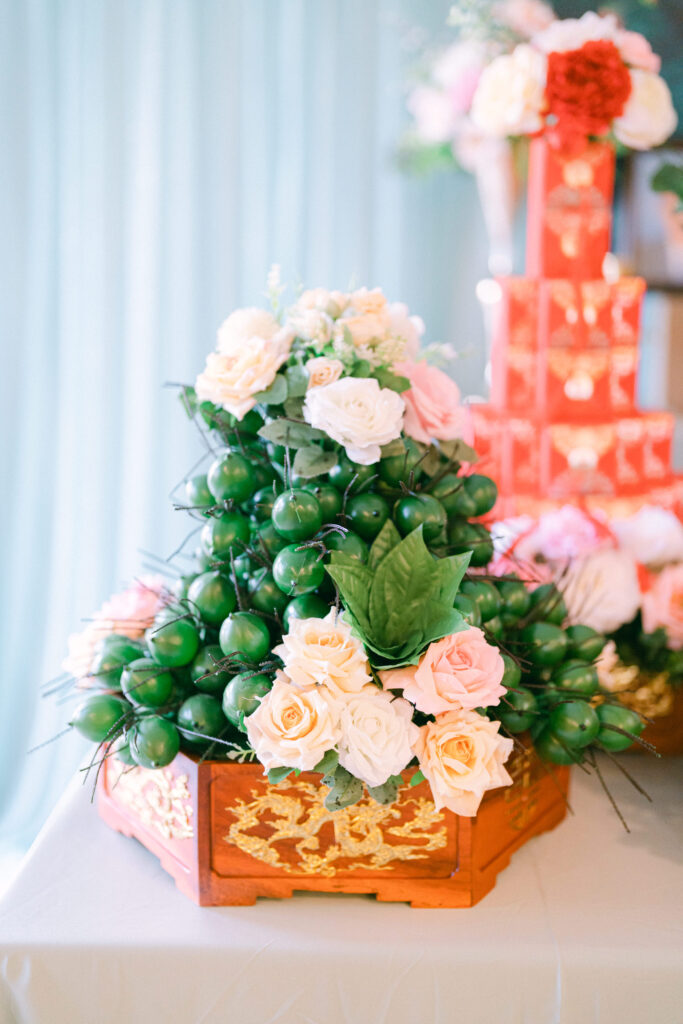
Tea (Trà): A staple in Vietnamese homes, representing warmth, hospitality, and the bonding of the two families.
Wine (Rượu): Symbolizes a bond that lasts a lifetime, much like a well-aged wine.
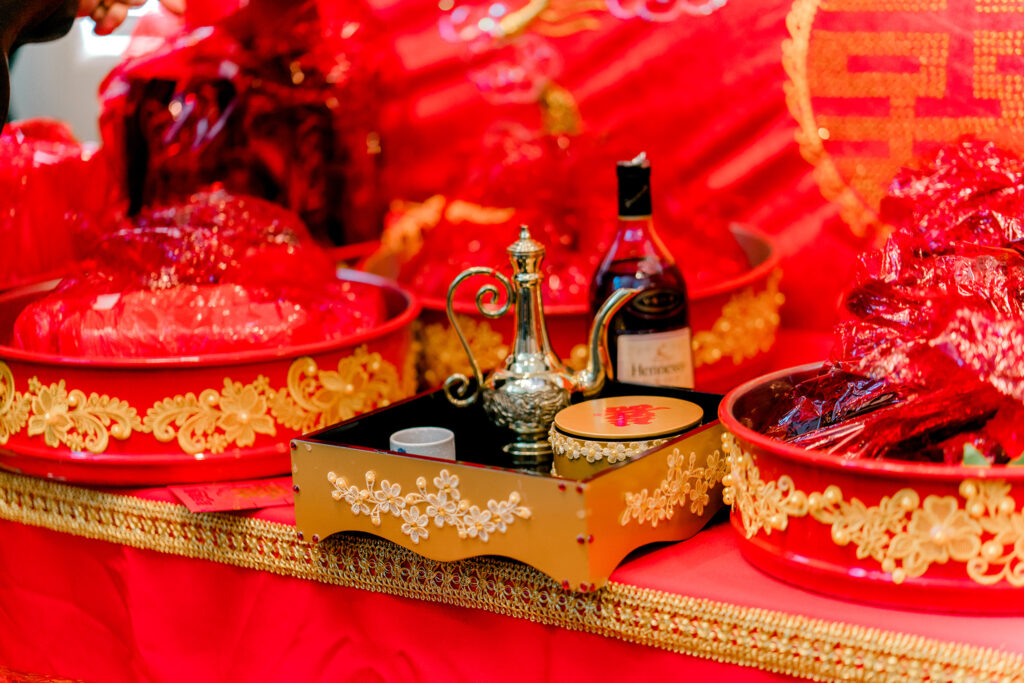
Dragon and Phoenix Fruits (Hoa quả kết rồng phụng): This refers to the traditional Vietnamese practice of arranging or carving fruits into the shapes of a dragon (rồng) and a phoenix (phụng) for a wedding ceremony. This display often forms part of the “mâm quả cưới” or wedding fruit tray, which is an important part of Vietnamese wedding customs. In Vietnamese culture, the dragon and the phoenix are two very symbolic creatures. The dragon represents the male or yang, and the phoenix represents the female or yin. When used together in marriage ceremonies, they symbolize the balance of male and female power and the wish for a harmonious and prosperous marriage.
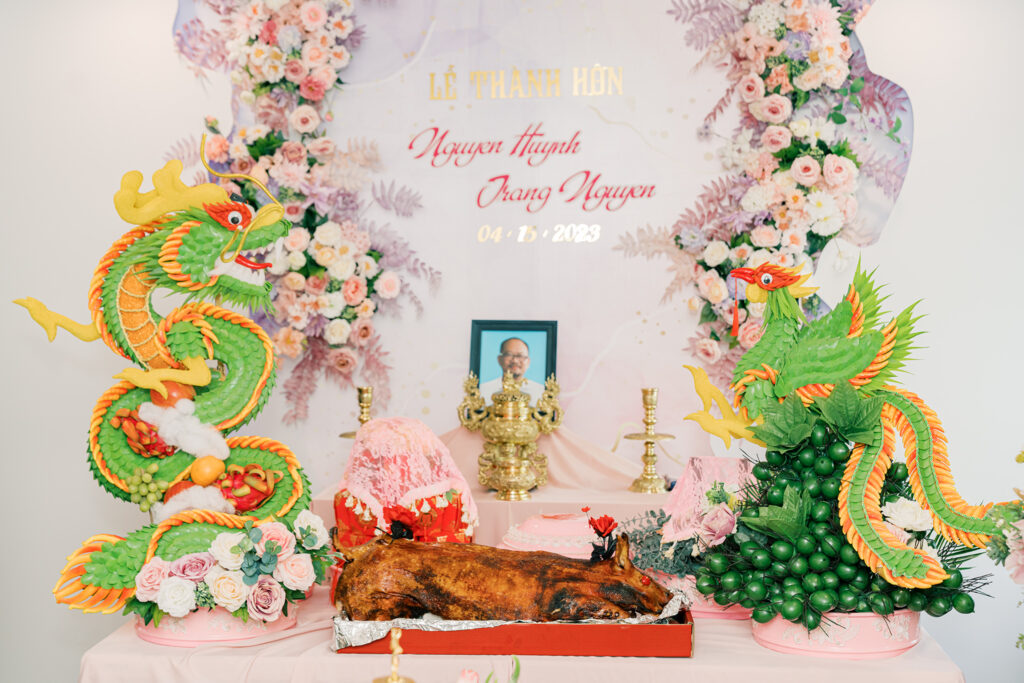
Cake (Bánh): Usually “Bánh Phu Thê” (husband and wife cake) is offered, symbolizing the sweetness of love and the hope that the couple’s life will be filled with happiness.
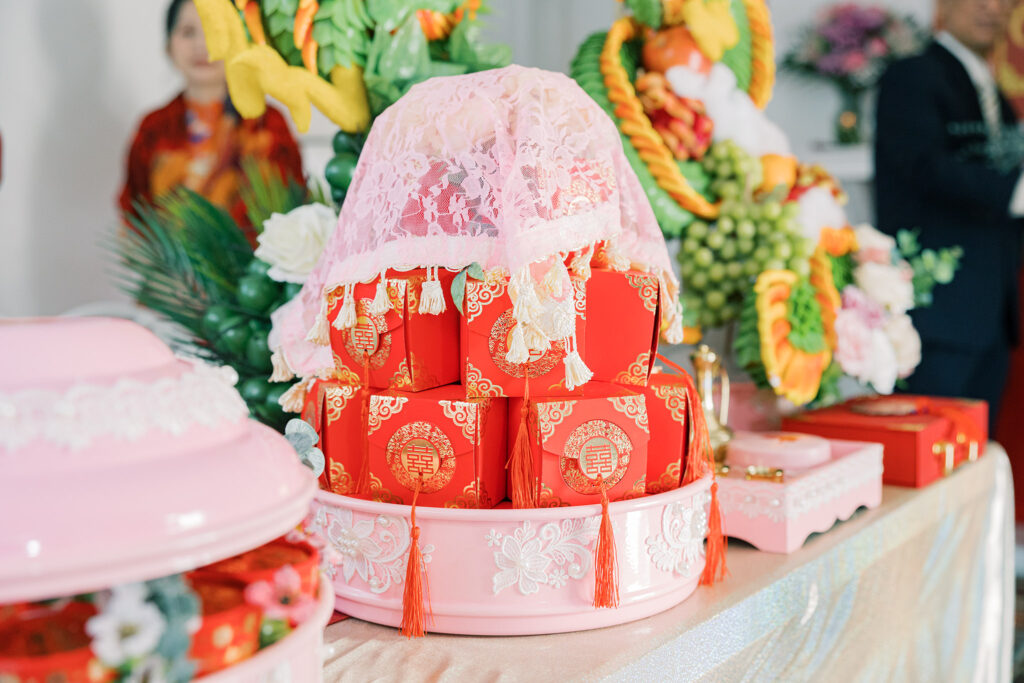
A roast pig (Heo quay): Represents purity and is offered as a sign of respect to the ancestors.
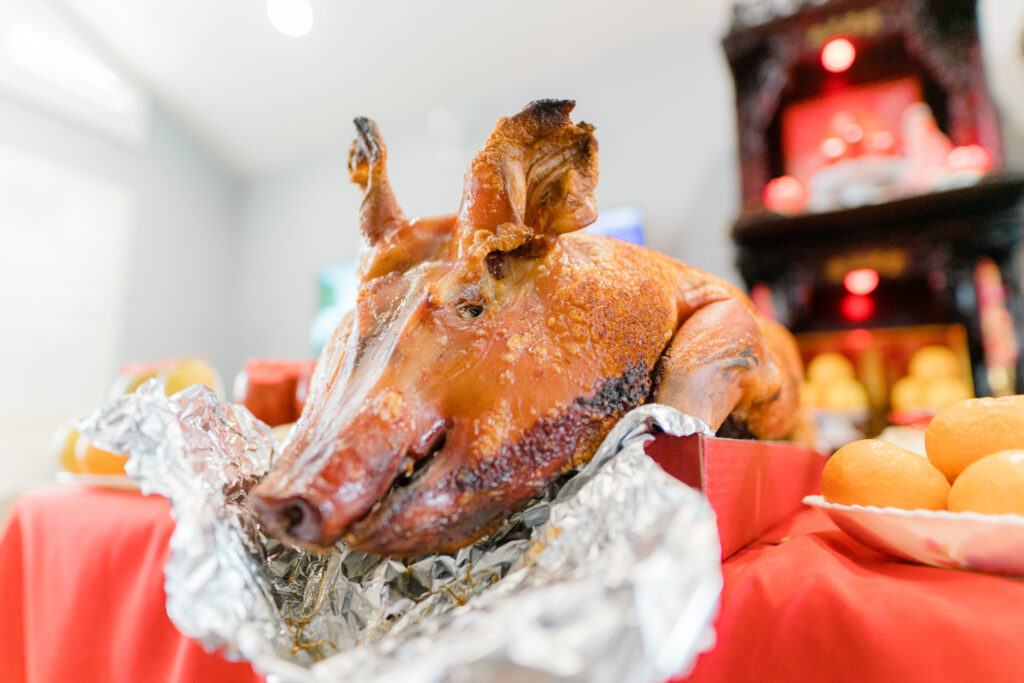
Jewelry for the bride (Trang sức): Often gold, this symbolizes wealth and good fortune
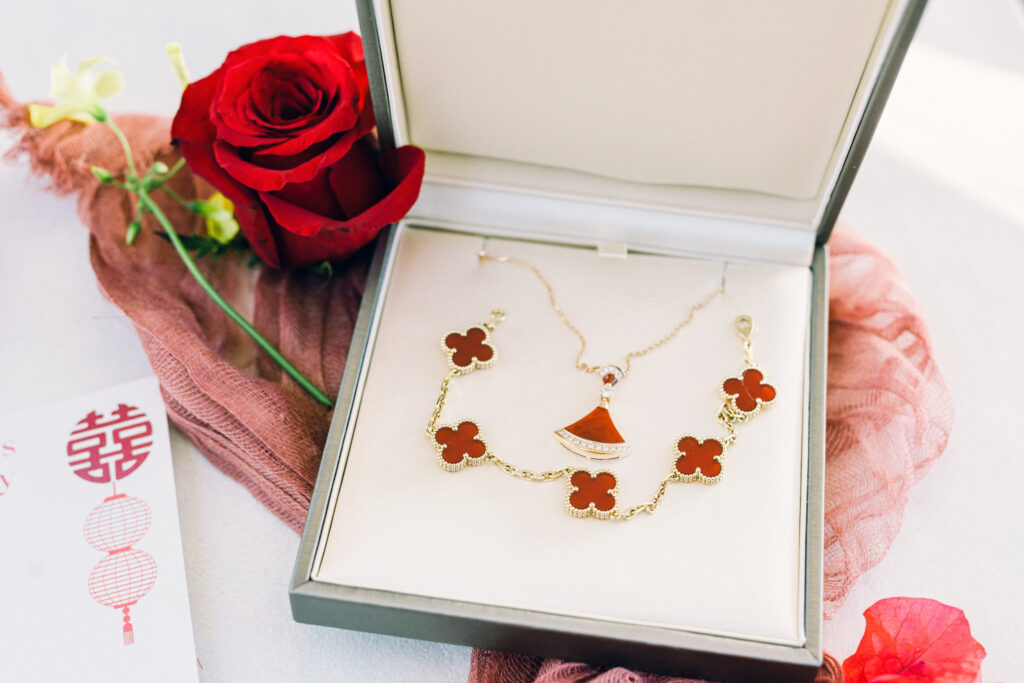
A pair of red candles (Nến): These symbolize the light and warmth that the couple brings to each other’s life.
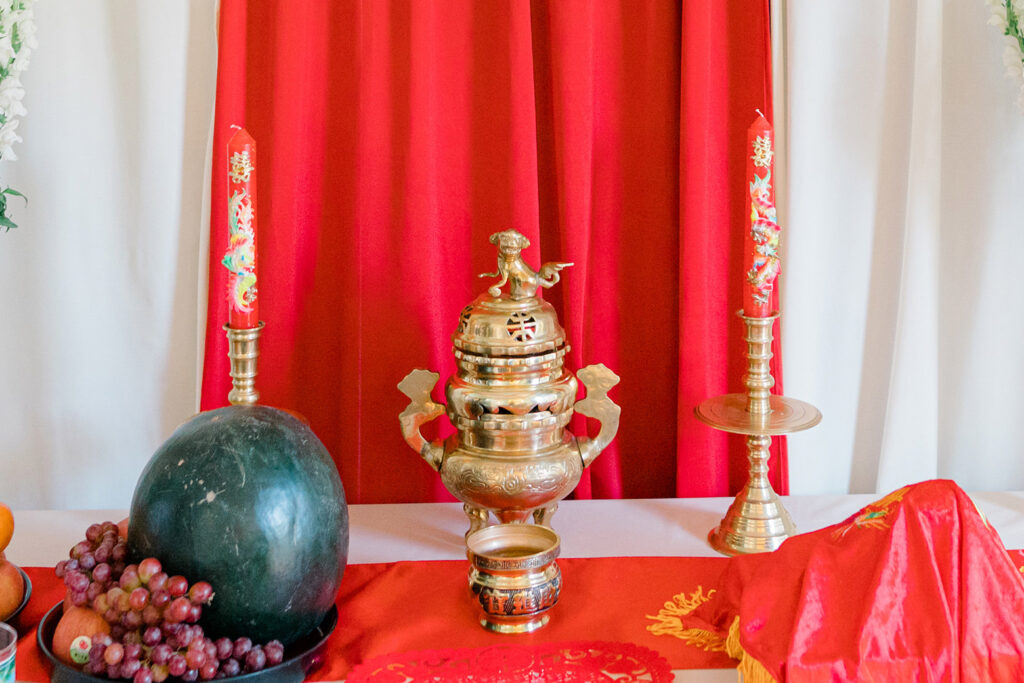
Each ‘Mâm Qua’ carries a special significance and adds a layer of depth to the wedding ceremony, beautifully intertwining material gifts with symbolic meaning.
Choosing Attire: The bride and groom traditionally wear Áo Dài, the Vietnamese national dress. The bride’s Áo Dài is often in red or pink, while the groom’s is usually in a darker color like blue or black. Some families may also have specific attire for family members involved in the ceremony.
Assigning Roles: Certain roles need to be assigned, such as the ‘MC’ who will guide the ceremony and the person who will officially receive the groom’s family. The roles are typically given to individuals who are well respected within the family.
The Ceremony at The Bride’s House: A Step-by-Step Guide

A detailed walkthrough of the entire ceremony at the bride’s house, broken down into the following steps:
- 08:00 AM – Preparation: Set up everything, from the altar to the tea set. Prepare the ‘Mâm Qua’ and ensure they are properly covered in red cloth.
- 09:00 AM – Arrival of the Groom’s Family: The groom’s family arrives at the bride’s house with the ‘Mâm Qua’. The bride’s family welcomes them.
- 09:15 AM – Exchange of Mâm Qua: Before entering the house, the two families exchange the ‘Mâm Qua’.
- 09:30 AM – Introduction of Family Members: Once inside, both families introduce their family members, starting from the eldest.
- 09:45 AM – Unwrapping of Mâm Qua: The bride’s family opens the ‘Mâm Qua’ to inspect the gifts.
- 10:00 AM – Appearance of the Bride: The bride’s mother escorts the bride out.
- 10:15 AM – Prayers and incense burning: The representative or eldest on the bride’s family burns incense sticks and bows to the ancestors. Afterward, the couple does the same.
- 10:30 AM – Exchange of wedding rings: Groom and Bride exchange the ring.
- 10:45 AM – Serving of tea and gift giving: The bride and groom serve tea to the grandparents, then parents. Parents give gifts to the couple, and then the couple serves tea to the rest of the immediate family.
- 11:30 AM – End of Ceremony: If there’s no plan to go to the groom’s house, this is the end of the ceremony.
Moving the Ceremony to the Groom’s House: A Step-by-Step Guide
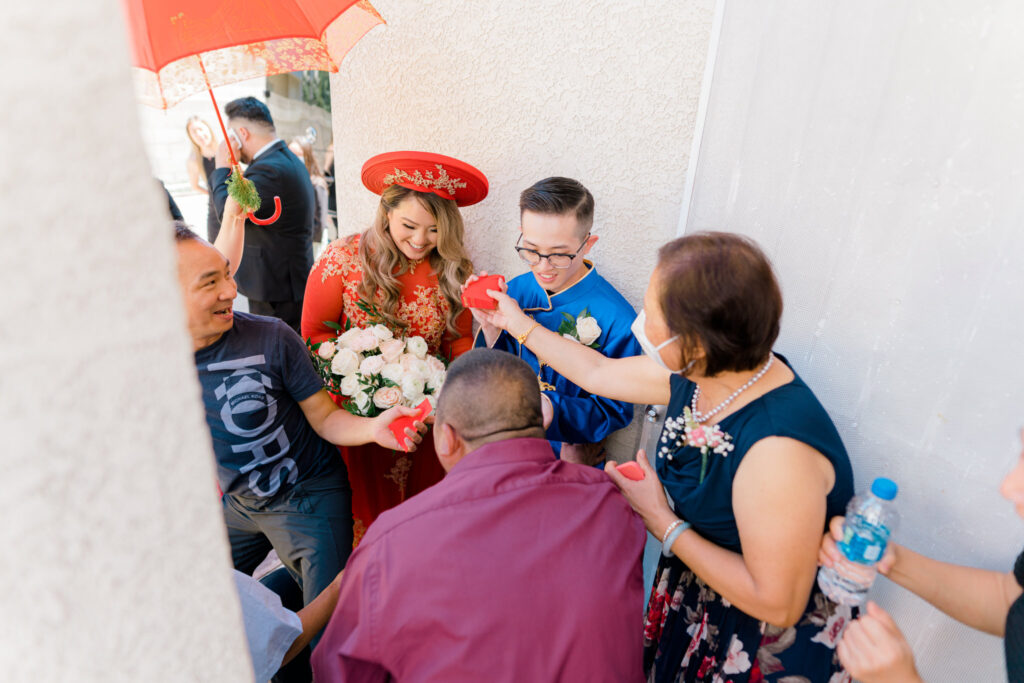
If the bride is being brought back to the groom’s house:
- 12:00 PM – Tra Qua or returning half the ‘Mâm Quả’: The bride’s family takes half the portion of ‘Mâm Qua’ and exchange it with the groom’s family in front of the house. The gifts are covered with half-folded red cloth.
- 12:30 PM – Entrance and introduction of the couple: The groom and bride walk into the house together, or the groom’s mother walks the bride in.
- 12:45 PM – Introduction of Family Members: The couple is introduced to the groom’s family members.
- 01:00 PM – Prayers and incense burning: The couple burns incense sticks and bows to the ancestors of the groom’s family.
- 01:15 PM – Serving of tea and gift giving: The couple serves tea to the groom’s parents and immediate family. They receive gifts from the groom’s parents and family.
- 01:45 PM – Wrap Up: The couple thanks everyone for attending and the ceremony concludes.
Please note that this timeline is an estimate and can be adjusted according to the specific customs of your family and the needs of the day.
The Significance of Each Step

Arrival of the groom’s family and Exchange of ‘Mâm Qua’: This signifies the official proposal from the groom’s family to the bride’s family. The ‘Mâm Qua’, or betrothal gifts, typically consist of tea, fruits, cakes, a roast pig, and other meaningful items, representing the groom’s family’s sincerity and wealth.
Introduction of family members: This part of the ceremony is to officially acknowledge each family member’s role and relationship within the family. The groom’s family members are introduced first, followed by the bride’s family members. This process emphasizes the importance of family bonds in Vietnamese culture.
Unwrapping of ‘Mâm Qua’: The bride’s family carefully unwraps and inspects the gifts. This is more than a simple act of unpacking; it symbolizes acceptance of the groom’s family’s proposal and recognition of the upcoming union.
Appearance of the bride: The entrance of the bride, traditionally dressed in a red Áo dài (Vietnamese national costume), is a significant moment. The color red is chosen for its association with luck, happiness, and prosperity.
Prayers and incense burning: Prayers and incense burning are meant to pay respects to the ancestors, seeking their blessings for the couple. This also reflects the importance of ancestral worship in Vietnamese culture.
Exchange of wedding rings: The ring exchange is a universal symbol of the couple’s commitment to each other. In Vietnamese culture, this commitment extends beyond the couple to include each other’s families.
Serving of tea and gift giving: The bride and groom serve tea to their parents and family elders, symbolizing respect and gratitude. The elders, in turn, give the couple their blessings and symbolic gifts, such as jewelry or words of wisdom.
Conclusion
Bridging the Past and Future: As a bride, embracing the Vietnamese tea ceremony is a powerful nod to the rich heritage that has shaped your identity. This ritual, steeped in tradition, offers a chance to connect to your roots, and through it, you form a link in a chain that stretches back generations. It underscores the continuity of cultural practices, reminding us that even as we step into a new phase of life, we carry forward the collective wisdom of our ancestors.
Preserving Culture, Creating Memories: While modernity has influenced many aspects of our lives, preserving these treasured cultural rituals ensures that they are not lost to time. By choosing to include the tea ceremony in your wedding, you are not only creating unforgettable memories for yourself and your family but also playing a crucial role in the conservation of a beautiful tradition.
Personal Values and Identity: More than just a ceremonial rite, the tea ceremony is a personal testament of your values. The respect for elders, the significance of family, and the sanctity of marriage are all beautifully symbolized in this ritual. As a future bride, you are embarking on a new journey, and this ceremony signifies your dedication to these timeless values.
Expression of Gratitude: As we conclude, take a moment to appreciate the depth of this ceremonial experience and reflect on the meaning it imparts to your wedding. It’s an opportunity to express your gratitude not only to your family but to all the generations before who have carried these traditions forward.
Embracing the Future: Lastly, as you approach your wedding day and the exciting new chapter it represents, consider the significance of the tea ceremony in your unique journey. The rituals might adapt to the shifting sands of time, but their core essence remains the same, much like the constant in a changing world. Your commitment to this tradition serves as a testament to the endurance of these practices, and in turn, you become a part of its legacy.
Bridal journeys are deeply personal and unique to every individual. Incorporating the Vietnamese tea ceremony into your special day is a choice that pays homage to the rich tapestry of culture and tradition that you belong to, as you step forward into a beautiful new beginning.
Invitation to Engage
Participate in Our Community: Your thoughts and plans for your wedding day are of great value. How do you envision incorporating the Vietnamese Tea Ceremony in your celebrations? Have any unique ideas that merge tradition with your personal touch? We invite you to share your vision in our comments section below. Your ideas could be the spark of inspiration for other brides-to-be!
Spread the Knowledge: Did you find this guide informative? Help us reach out to more future brides by sharing this post on your social media channels. By sharing, you’re bringing visibility to the wonderful Vietnamese traditions and offering valuable insights to other brides in their wedding planning journey.
We’re Here to Help: Organizing a wedding can be a complex process, and we understand that you might have unique questions about planning your own Tea Ceremony. If you are looking for Southern California Wedding Photographer or specifically in Orange County and Los Angeles area. Don’t hesitate to get in touch with us. Our team, rich in tradition and practical knowledge, is on hand to offer personalized advice to make your wedding truly unforgettable.
Stay in the Loop: Want to keep abreast of the latest in Vietnamese wedding traditions? Stay connected with us by subscribing to our blog or following our social media pages. You’ll be the first to receive our newest posts and updates, offering continual inspiration for your special day.
Share Your Story: Attended a Vietnamese Tea Ceremony recently? We’d love to hear about your experience. Sharing your personal stories provides a wealth of practical knowledge that can guide others in their planning.
Remember, your voice has power. Your journey can illuminate the path for others, and your questions can stimulate discussions and solutions. We eagerly anticipate your engagement and are thrilled to be part of your wedding planning journey.
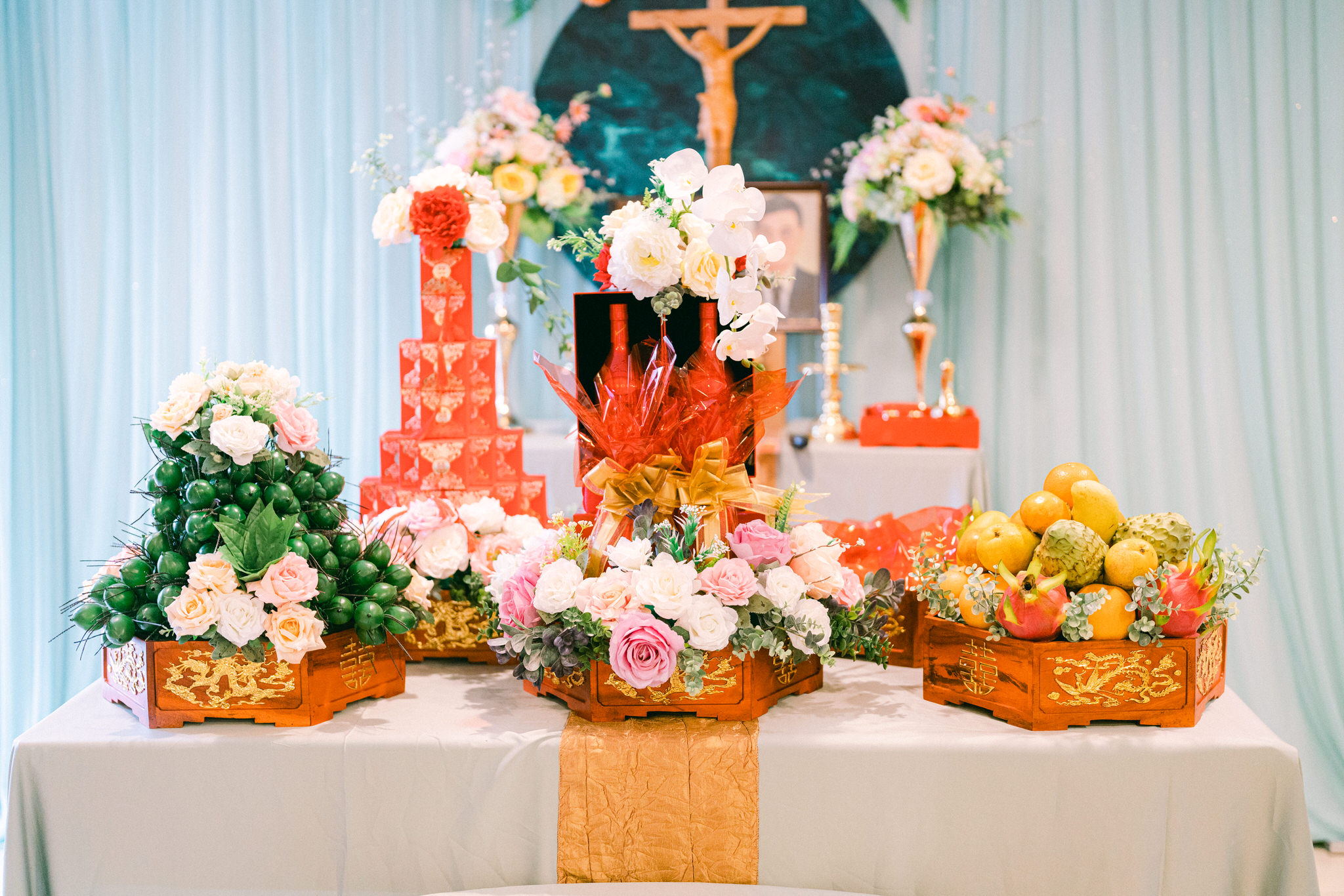
add a comment
+ COMMENTS